- Home
- Sprained ankle
- Ankle fracture
Ankle fracture
Ankle fracture is obviously in the first instance a job for an orthopaedic surgeon.
Research shows that, despite injuries, most people who engage
regularly in sporting activities are much healthier than their couch
potato counterparts. Generally they have less pain, from arthritis for
example; however there are a lot of ifs and maybes.
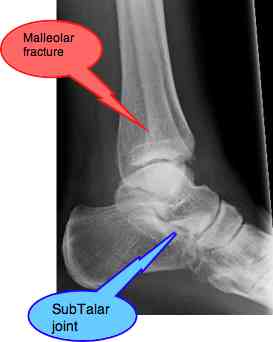
This page was last updated by Dr Barrie Lewis on 1st May, 2020.
Today we are focusing on the subtalar joint.
It really consists of three parts allowing for the rolling action of the talus on the heel-bone, or calcaneus.
The subtalar joint allows for the rolling action of the foot, so-called inversion and eversion, and thus a vital part of the normally functioning ankle.
It's complex because it is really three joints in one. Let us look at the function of the anterior and posterior parts of the subtalar hinge, between the talus and the calcaneus below it, remember.
Subtalar joint
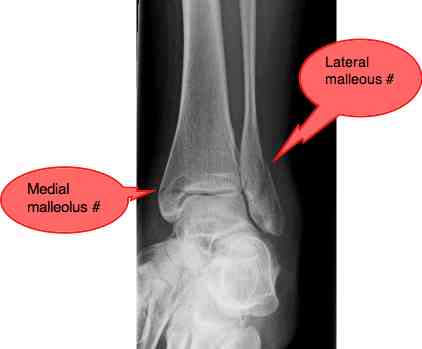
Ankle Fracture
The diagram below gives a very simplistic idea of the
- ankle mortise and
- subtalar joint ankle anatomy.
In fact they are extremely complex joints.
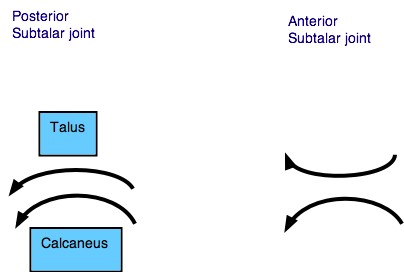
Ankle fracture suggests after the cast is off it is time to think chiropractic as there are virtually always subluxated bones and ligament damage too. It is certainly one of many potential chronic joint pain causes.
CASE HISTORY
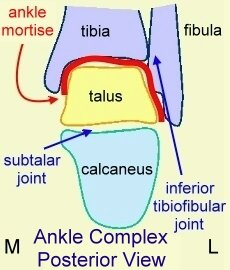
Now to see how an ankle fracture can affect the subtalar joint too, even though that is not where the fracture was; this case history will illustrate the dangers of not having an injured lower limb properly assessed.
Mrs S fell off her bicycle when she took her eye off the road ahead, where her husband was riding, to look at a helicopter passing by. He braked and she didn't notice until too late, her front wheel touched his and she fell off, striking her ankle on the curb.
She had immediate severe ankle joint pain, and guessed the worst, but they were miles from anywhere. She was unable to walk, but by using the other foot for power she was able to ride to the nearest help. X-rays confirmed two fractures.
The lateral malleolus was plated by an orthopaedic surgeon and her ankle was put into gips, plaster of Paris. The ankle fractures healed perfectly well and the severe pain subsided; the doctor was supremely happy with the result, but Mrs S was not.
She could only walk one step at a time.
The surgeon played down any need for therapy. It will heal on its own. Just give it time.
But it did not; a sister in a major hospital, she used her own initiative and took herself off to physiotherapy. After fourteen weeks, she had greatly reduced pain, but the ankle still swelled alarmingly during the day, and walking remained difficult and very restricted, and deep in the joint she had stabs of pain.
Eight further physical therapy treatments had not helped a great deal either. What certainly contributed was the ankle exercises given. Those would be more beneficial once the subluxation of the calcaneus and talus bones had been reduced.
She walked into the clinic, unable to dorsiflex or evert the ankle, giving her a strange step-before-step gait. Not surprisingly, you cannot walk normally with a fixated subtalar joint, and the ankle mortise joint was also restricted.
Ankle joint pain
Ankle joint pain is inevitable after ankle fracture.
CONSULT 1:
Her husband being a patient, asked for advice. "Send her for a "kennismaking-gesprek", a getting-to-know-the-doctor consult," I suggested, having no idea whether I could help her ankle joint, or not. Holland is unique as far as I know in that patients are often advised to first consult a new doctor (for no charge) when they have no illness, just so that s/he can go through the patient records without the worry of a new crisis. In Chiropractic we use it to great effect for the patient who is anxious or uncertain about whether to consult a chiropractor. There's no treatment. A short consult, eyeball-to-eyeball, a brief exam, "do I want to trust my bod to this doctor" (my doctor says he's a quack, and I may end up in a wheelchair, or have a stroke).
From the chiropractor's point of view, it is an opportunity to see if this is a condition where Chiropractic can contribute. After fracture, there was doubt on my side too... an examination of the ankle takes no more than five minutes, a few more to view the X-rays, and a little more to explain to the patient the philosophy of Chiropractic. In this instance particularly what will happen to the hyaline cartilage in her ankle joint if the normal movement is not restored?
Immobilisation arthritis is the remorseless progress of degenerative change in a joint unable to move freely.
ASIDE: Kennismakensgesprek. I think chiropractors the world over can learn from the Dutch practice of having a no-charge meet-the-doctor consultation. Short, to the point, a very brief examination, and a short report back over whether in our opinion Chiropractic could help the patient. It almost alwasy leads on to a First Consultation, obviously at full charge.
Many, many patiets have conditions which are not responding well to Medicine, but they are anxious about consulting a Chiropractor. The kennismakensgesprek (I can't find a suitable English term) that involves no charge and no treatment is exactly the nudge they need to get into Chiropractic. I mean, who would have thought that an ankle fracture that was responding very poorly to surgery, fourteen weeks of physiotherapy and four weeks of physical therapy was actually a case for a Chiropractor?
CONSULT 2: FULL HISTORY and EXAMINATION @ ANKLE FRACTURE
Mrs S is a petite middle aged woman; her weight is perfect at 56 kg. Fortunately she is also a non smoker; difficult fractures don't heal well. Surprisingly, there were minimal findings in her low back or pelvis; that's usually the case after three months of limping, six of them with a heavy cast. No fixations, nor restricted range of motion, only some tenderness of the left sacroiliac joint.
The consult was early in the morning, and minimal swelling was visible in the ankle joint. But by the end of the day, it's a different story, she tells me. A fine scar was visible where the lateral malleolus had been successfully plated.
Dorsiflexion was slightly limited at 15 degrees; normal is 20.
Plantar movement was more limited at 30 degrees; 50.
Subtalar inversion was normal at 5 degrees; fortunately it was not increased, a sure sign of torn ligaments.
Subtalar eversion was zero; normal is 5 degrees. The joint was solid as concrete. Here lies the problem.
There was no increased range of motion, so clearly the ligaments were intact. Interesting that they are often stronger than bone.
Bone breaks before any ligaments rupture. It is no coincidence; it was designed that way as they heal far better than the soft tissues.
Fortunately the slight movement between the lower tibia and fibula bones, the so called inferior tibio fibular syndesmosis, a slightly moveable joint which often ruptured with a trans malleolar fracture, appeared normal.
Rupture of the anterior inferior tibio fibular ligament, the most commonly injured ligament in an inversion ankle sprain, the posterior inferior tibial fibular and the strong inter ossesous ligament appeared unlikely on manual palpation of the joints. They are vital to maintain the stability of the ankle mortise joint.
- AITFL
- PITFL
- IOL
MUSCLES
There was no weakness or pain on resisted isometic contraction of the ankle joint muscles. Tightness and deep tenderness in the Achilles tendon and soleus muscles were found. There were no active trigger points.
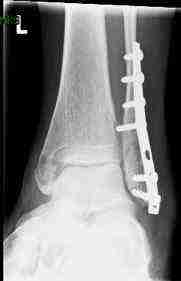
PHILOSOPHY OF CHIROPRACTIC
"The world is indoctrinated in
medicine. People are born in a medicine cabinet and grow up in a
drugstore. They have been brainwashed, hypnotized, mesmerized and
drugged to believe their life-force comes from the Outside-In.
Chiropractic must un-brainwash them and demonstrate that health comes
from Inside-Out."
Dr. B.J. Palmer, D.C.
All patients know the basis of Medicine, but very few know much
about Chiropractic, so I always start with a brief explanation of the
rationale behind Chiropractic therapy. CHIROPRACTIC THERAPY covers a fuller discussion.
TREATMENT PROTOCOL after Ankle Fracture
Further, I explained to Mrs S the three phases of Chiropractic care.
How I would need to see her
- twice a week for probably 3-4 weeks in the TREATMENT PHASE, and thereafter
- the importance of a REHAB PHASE.
Continuing to do some simple but vital exercises to restablish muscle
tone and suppleness, stretching of that achilles tendon, and getting the
normal proprioception back into the joint and tissues was vital.
Otherwise more foot and ankle pain and twisted ankle was likely in the
future.
ASIDE: I find that patients with heel spurs and chronic foot pain almost always have a subtalar fixation, probably stemming from an old sprained ankle, or perhaps ankle fracture.
- In her case, an occasional treatment in the MAINTENANCE PHASE
may or may not be needed. With such a slim, active woman, if she
continued to do the exercises, I suspected that I may be able to
discharge her without the need for the occasional, regular treatment
usually necessary for more chronic conditions.
I gave her some simple "alphabet" exercises, and the first chiropractic treatment for her foot and ankle pain.
FUNCTIONAL INSTABILITY with Ankle Fracture
It is now commonly accepted that after fracture and ligamentous damage (so-called MECHANICAL INSTABILITY), that Functionaj Instability often follows. Sudden, slight inversions of the ankle are detected by mechanical receptors deep in the ligaments of the lateral ankle, instantly activating the Peroneal muscles, responsible primarily for eversion.
Failure of these of these mechanical receptors to activate the nerve responsible (Superficial Peroneal nerve) results in Functional Instability.
Rehab of the joint complex, and the nerves and muscles involved in this "proprioceptive" action is vital to prevent Functional Instability[1]. (Bozzelle, Kishner, et al. April 2010). They report a 80% recurrence rate for lateral ankle sprains.
CONSULT 3:
Subjective: Mrs S reported some temporary "after pain" after the first treatment, which she handled easily with ice treatment.
Objective: The range of motion of the ankle joint was still limited and restricted in both the ankle mortise (dorsi- and plantar-flexion), and subtalar joint (eversion).
Assessment: No change in the condition.
Plan: Chiropractic manipulation of the talo-tibial (mortise) joint and the talo-calaneal (subtalar) joints. Checked that the exercises were being done correctly.
CONSULT 4:
S: Mrs S reported that walking was better. O: There was perhaps some improvement in eversion, though not in plantar- and dorsiflexion. A: Progressing as expected. P: As before.
CONSULT 5:
S: Mrs S reported that she could walk much better, without the deep stabs of pain. The ankle still swelled in the late afternoon. O: Eversion was definitely improved. Dorsiflexion remained very tight. A: Time to start with Active Release Treatment of the achilles tendon. P: Add ART to the regimen.
ASIDE Today a new patient. A tall young man of 33, three
years ago a successful back operation by all accounts, but with a
chronic old ankle injury. In March he had an ankle operation to improve
eversion of the ankle, but the increased limping after the operation,
has set off a terrible sciatica. The case is further complicated by a
short leg on the same side - leg length inequality - and mildly
restricted hip flexion and adduction... probable Femoro acetabular
impingement syndrome. Eversion of the ankle was zero, and the Flip test for sciatica
extremely positive. All of these will have to be addressed for a
successful outcome.
CONSULT 6: ANKLE FRACTURE
S: Mrs S is progressing magnificently, far better than expected. Her halted stepping gait was over and she could walk relatively normally. The ankle still swelled in the evenings, but much less so, she reports.
O: There is at least 2* of eversion now, and dorsi- and plantar-flexion are improving.
A: Improving better than expected**.
P: Introduce resistive eversion exercises using an old bicycle tube. Suggest she purchase a wobble board***.
Ankle anatomy
Ankle anatomy will help you understand what has happened after an ankle fracture.
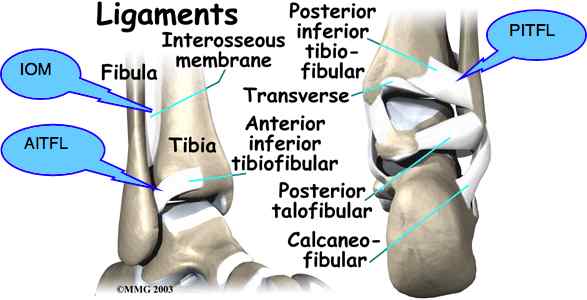
Foot pain
Foot pain is a common sequela after ankle fracture.
CONSULT 7
S: Still better. She reports she can now walk down the stairs for the first time without difficulty.
O: Still a slight limp. No oedema (but it's morning). Dorsiflexion is normal now, plantar flexion and eversion still limited. The achilles tendon is quite thick and stiff.
A: Good progress.
P: Ask her husband to stretch the achilles tendon every evening. Alas it's "afscheid-dag". Those long Dutch words. I'm going into semi-retirement, and have had to hand her over to a colleague. "Divorce day", literally translated.
"Ik ga achter de geraniums zitten."
"Sitting behind the geraniums" is a euphemism for going into
retirement! Except it will be sitting behind the Cape violets! Niet
echt, not really, just nice to joke.
- How reliable are X-rays? The terrible consequences of a missed ankle fracture.
Ankle exercises
Ankle exercises are very important after ankle fracture.
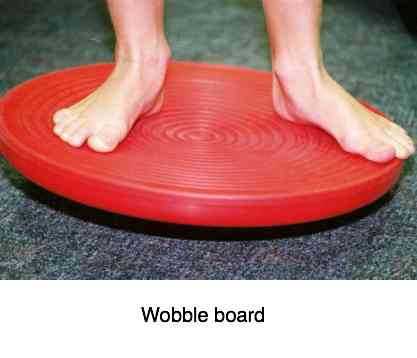
** It goes without saying that non-smoking (smoking reduces the partial
pressure of oxygen in the blood by about 20%), non-obese, active and fit
people eating a diet rich in the right nutrients are going to heal much
faster.
*** Watch this space for "Make your own Wobbleboard for less than two dollars".
Update: I confess that whilst my carpentry shop is set up, I've been building stairs for our new apartment. But the wobbleboard is not forgotten, just on the backburner. Meantime, just buy one, they're not expensive. Further apologies to those waiting patiently for instructions on how to make a
wobble board. The swarming season is about to begin and I am totally in
the midst of clearing the jungle for an apiary. But carpentry is my
second hobby, after bees... we'll get to the wobble board.
What if you have no treatment?
I regularly get requests for advice from readers who have fractured a bone in the their ankle, but for one reason or another they never consulted a doctor of any ilk and it was not treated. What can happen if you have no treatment?
That could be because the fracture was missed. Or perhaps the patient refused to go into a cast, or... there are many reasons. I broke my ankle 14 years ago but it was never treated is one such case; it makes sobering reading.
Atherosclerosis
Atherosclerosis will reduce the blood flow, making ankle fracture a more complex business. Without oxygen bones don't knit well.
Anything reducing oxygen and nutrients reaching the fracture site is also going to impede progress. Smoking, for example, is the single biggest risk factor in surgery. So too are arteries clogged with cholesterol.
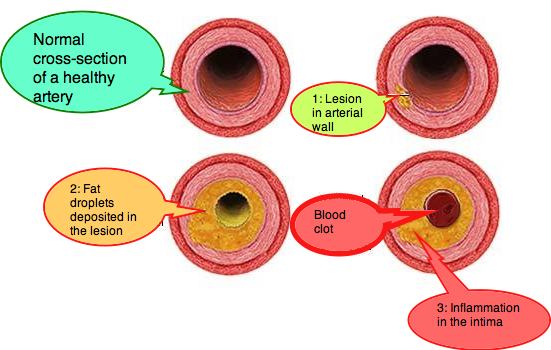

With all the evidence now coming out about the side effects of Statins, including impotence, it's imperative we all start to include foods that lower cholesterol in our diets. It's not rocket science, and it is soundly and scientifically proven. Just adding oats, hummus and an apple a day to your diet will profoundly affect your cholesterol profile.
Include daily a portion of fatty fish or tablespoon of freshly ground flaxseed on your morning cereal for omega 3; then you are two steps forward.
A daily salad, rich in phytosterols, completes the anticholesterol bouquet.
Avoid fried foods from a fast food restaurant; the very worst is oxidised fat from repeated frying.
Actually
interesting new research is suggesting that the real culprit is starches
with a high glycemic index; they raise our cholesterol, rather than too
much fat. Read more about it at our Banting diet page.
Also foods to avoid high cholesterol should only be enjoyed in moderation, obviously.
Diabetes osteoporosis
Diabetes osteoporosis is a disease that affects the hormone and mineral balance in the body. Because of the calcium imbalance, diabetics are also more prone to broken bones. That could cause low back pain, a cracked wrist or in fact any bone in the skeleton including an ankle fracture.
Having said that, diabetes osteoporosis is a very preventable disease, but certain lifestyle changes are vital; for most type 2 diabetics it's either lose a lot of weight, or a life without medication becomes a pipe dream.
When browsing these links use right click and "Open Link in New Tab", or you may get a bad gateway signal.
Have A Question About Your Foot?
Share your question. Perhaps I or someone else can contribute to the misery that foot and ankle joint pain can cause.
What Other Visitors Have Said
Click below to see contributions from other visitors to this page...
Chiropractic treatment of conditions affecting the metatarsal bones Not rated yet
Home > Ankle fracture > Metatarsal ailments
About three years ago I sprained my ankle playing tennis. I was unable to put …
Scan
The bones in the ankle and midfoot overlap to such an extent that it is notoriously difficult to get a true picture after serious injury. When in doubt, get a scan. MRI does not use ionising radiation; it's safer but not as good as CT for detecting a fracture.
I am currently treating a man who fell ten feet. X-rays are negative but he simply cannot afford a scan. I was happy to treat him, a year after the injury, but seriously suspect that there is a fracture lurking unseen.
There was absolutely zero progress with physical therapy, and after about three months of treatment he is fifty percent better, and now walks almost normally.
The uncertainty remains... I'm not expecting much further improvement.
Rule of thumb: If in doubt, get a scan if clinically a fracture is suspected, but is unseen on plain X-ray.
- Home
- Sprained ankle
- Ankle fracture
Did you find this page useful? Then perhaps forward it to a suffering friend. Better still, Tweet or Face Book it.
